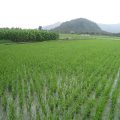A former municipal agriculturist reaped a whopping 306.8 cavans in his one hectare land in Isabela after integrating his learning from government service into hybrid rice farming.
Dionicio Tamayao, 44, was an agriculture technician at the municipal agriculture office (MAO) in Reina Mercedes, Isabela with a function to help farmers achieve high yield.
Now it is he who is reaping the benefits of his knowledge on technology.
“I just raised the amount of fertilizer that I use in my farm. I was just harvesting 180 cavans per hectare before. It’s now almost doubled,” said Tamayo.
His harvest of 306.8 cavans has been certified correct by Isabela’s provincial agriculture office.
He started planting hybrid rice in 2004 as a government mandate for him to conduct a technology demonstration of hybrid rice. The government then had a target to plant hybrid rice on 300,000 hectares in order to help Filipino farmers raise their income.
He used to be the only one then working on hybrid rice. But he has since inspired many Isabela farmers to try the high yielding rice variety through actual demonstration.
“Unless farmers see your grains, they won’t get convinced,” he said.
This 306.8 cavan harvest from one hectare came from his 2014 dry season yield. In 2015 dry season, he harvested a lower 280 cavans per hectare—which is still far higher than his former inbred rice harvest.
The town Reina Mercedes now has 1,467 hectares planted to hybrid rice, mostly SL-8H, out of its total 3668 hectares.
From the normal harvest of 60 to 100 cavans per hectare using inbred rice, he began harvesting 180-200 cavans primarily from SL-8H hybrid rice.
This time, though, effective fertilization and well-learnt irrigation system are key to his enjoying a big harvest.
He doubled his application of urea from three bags to six bags; phosphorus from two bags to four bags; and muriate of potash, from one bag to two bags.
His additional cost from the increase in fertilizer use was only P5,000 on top of the regular P30,000 fertilizer expense.
But his gross income from this 15,340 kilos from one hectare amounts to P299,130. And his net income hovers around P220,000-240,000. That is a hefty increase from the former net income of P95,500-P115,500 from a well-fertilized SL-8H farm.
However, fertilization is not the only key to higher harvest, although it is the major factor.
He practised intermittent irrigation. He only irrigated the farm when moisture was needed.
“If there’s too much water the grain doesn’t get well-filled, and I observe pests,” he said.
He also uses organic fertilizer in his rice farm. This comes from the hog manure from his tended pigs that produce 15 bags of decomposed organic fertilizer.
“I wait for the manure to get fully decomposed in five to six months before application,” he said in Filipino.
He is also now keeping a small area for vermiculture and hopes to put in more vermicompost for his farm.
All these he learned from being a government farm technician.
He admits his use of hybrid rice, which he has not stopped since 2004, has not been totally a haven of harvest increases.
“There was a time that there was failure in germination. We were also hit heavily in Isabela time by BLB (bacterial leaf blight) in 2007, 2008, 2009. We were getting discouraged. But every year, we did techno demo which later proved to inspire farmers visiting our demo site,” Tamayao said.
###
For any questions or interview requests, please contact 0999-573-7077 or 0917-671-1596.



